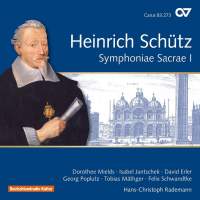Texte paru dans: / Appeared in: |
|
|
Outil de traduction ~ (Très approximatif) |
|
|
Reviewer: James
A. Altena The first of three collections bearing this name, published in 1629, was another fruit of Schütz’s rich times of study in Venice, first from 1609 to 1612 with Giovanni Gabrieli, with whom he became fast friends, and then again from 1628 to 1629, this time with Claudio Monteverdi. (Schütz returned to Dresden opportunely, as shortly after his departure Venice was devastated by a plague that killed about one-third of the populace.) Whereas in most of his other works Schütz left the instrumental scoring unspecified, here he designated exactly which instruments he wanted in each selection, resulting in a richly varied sonic palette. Especially striking are his two great sacred arias Fili mi, Absalom and Attendite, popule meus (SWV 269 and 270), scored for the unusual and potent combination of solo bass voice, four trombones, and continuo, providing an especially rich and solemn declamatory power. They remain my benchmarks for initial evaluation of any set of these pieces. (Full disclosure: I’m a basso profundo and a onetime trombonist, who has sung these two excerpts as well as the Jubilate Deo, SWV 262, for bass voice and two recorders or violins, so I’m deeply invested here.)
In 39:5 I
expressed my great disappointment with a set of the Symphoniae Sacrae I by
the normally excellent Manfred Cordes and his Weser-Renaissance Bremen
ensemble. Here, in the ongoing Carus edition of the complete works of Schütz,
we have a generally excellent set to make up for that, with uniformly strong
vocal soloists supported by 15 skilled instrumentalists. As always, Carus
provides top-notch recorded sound, detailed booklet notes, and full texts
with translations. In that previous review I touched upon the four other
previous complete sets up to that time: the premiere version from 1984 with
Hans Grüß and the Capella Fidicinia on Berlin Classics (substandard and
badly dated, and not considered further here); the 1991 set with Concerto
Palatino on Accent; the 2003 edition with Matteo Messori and the Cappella
Augustana on Brilliant Classics; and the 2010 version with Roland Wilson and
the Musica Fiata on Deutsche Harmonia Mundi. The latter three and this new
set are all first-rate and very close in quality. Having now listened
closely to all of them together, I would award first place by a nose to
Wilson, with this set and the Concerto Palatino tied for a close second, and
the Messori set a slightly more distant third due primarily to a
considerably less ingratiating tenor soloist. The advantage of the Wilson
set is its greater sense of direct emotional engagement, whereas the other
three all pursue a cooler, more objective aesthetic. I am a bit put off by
both Wilson and Rademann taking sections of Fili mi, Absalom at gratuitously
accelerated tempos, robbing that mighty lament by King David of some of its
majestic power, but not enough for that to overrule their strengths
elsewhere. Unfortunately both the Wilson and Concerto Palatino sets
apparently are presently out of print, though the former can be had quite
cheaply on Amazon and the latter is available inexpensively as an mp3
download. The Messori is now in print only in a 19-CD set of miscellaneous
Schütz works from Brilliant Classics’ aborted complete Schütz edition. For
an in-print, stand-alone CD version of this collection, the field now
belongs to this very fine newcomer, which is heartily recommended. | |
|
Support us financially by purchasing this disc from eiher one of these suppliers. Un achat via l'un ou l'autre des fournisseurs proposés contribue à défrayer les coûts d'exploitation de ce site. |
|
|
|
|
|
Cliquez l'un ou l'autre
bouton pour découvrir bien d'autres critiques de CD |
|




